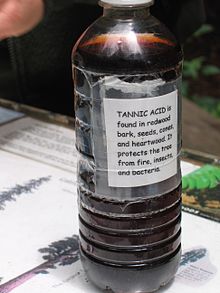
Back Tannien Afrikaans عفص (مادة) Arabic Tanín AST Таніны Byelorussian Танин Bulgarian ট্যানিন Bengali/Bangla Tanin BS Taní Catalan Třísloviny Czech Tannin Danish



Tannins (or tannoids) are a class of astringent, polyphenolic biomolecules that bind to and precipitate proteins and various other organic compounds including amino acids and alkaloids. The term tannin is widely applied to any large polyphenolic compound containing sufficient hydroxyls and other suitable groups (such as carboxyls) to form strong complexes with various macromolecules.
The term tannin (from scientific French tannin, from French tan "crushed oak bark", tanner "to tan", cognate with English tanning, Medieval Latin tannare, from Proto-Celtic *tannos "oak") refers to the abundance of these compounds in oak bark, which was used in tanning animal hides into leather.
The tannin compounds are widely distributed in many species of plants, where they play a role in protection from predation (acting as pesticides) and might help in regulating plant growth.[1] The astringency from the tannins is what causes the dry and puckery feeling in the mouth following the consumption of unripened fruit, red wine or tea.[2] Likewise, the destruction or modification of tannins with time plays an important role when determining harvesting times.
Tannins have molecular weights ranging from 500 to over 3,000[3] (gallic acid esters) and up to 20,000 daltons (proanthocyanidins).
- ^ Ferrell, Katie E.; Thorington, Richard W. (2006). Squirrels: the animal answer guide. Baltimore: Johns Hopkins University Press. p. 91. ISBN 978-0-8018-8402-3.
- ^ McGee, Harold (2004). On food and cooking: the science and lore of the kitchen. New York: Scribner. p. 714. ISBN 978-0-684-80001-1.
- ^ Bate-Smith and Swain (1962). "Flavonoid compounds". In Florkin M.; Mason H. S (eds.). Comparative biochemistry. Vol. III. New York: Academic Press. pp. 75–809.